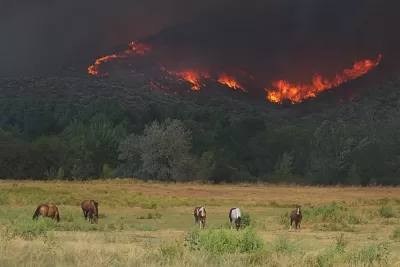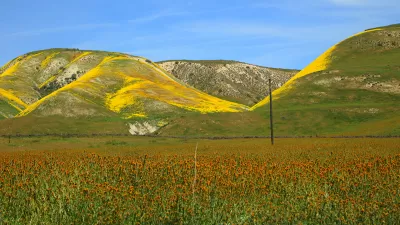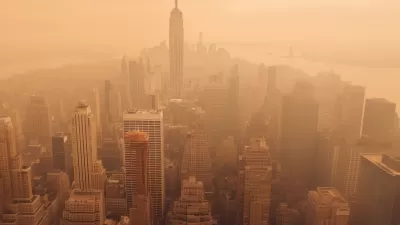While forests sequester atmospheric carbon dioxide, wildfires release enormous amounts of greenhouse gases as they increase in frequency and intensity from climate change.

It takes only one intense California wildfire to wipe out an entire year's reduction of greenhouse gas emissions overseen by the California Air Resources Board (CARB). The huge gap is illustrated in this San Francisco Chronicle graph (jpg) contrasting annual emissions reductions from 2013 through 2015 with emission contributions from wildfires (and those fires are just the ones on federal lands).
However, the U.S. Environmental Protection Agency and CARB only measure emissions from anthropogenic (attributed to a "direct result of human activities or are the result of natural processes that have been affected by human activities" per CARB glossary) sources for inventory purposes.
"The board has spent much of the last decade researching how to calculate and track wildfire emissions and is working on a year-by-year tally," reports David R. Baker on November 21 for the San Francisco Chronicle.
There’s a lot of uncertainties in quantifying this,” said Dave Edwards, chief of the board’s greenhouse gas inventory branch. “It’s not like power plants burning fossil fuels.”
“We can go from carbon sink to source in a five- to 10-year period,” adds Dick Cameron, director of science for California land programs at the Nature Conservancy environmental organization.
One study commissioned by the Air Resources Board estimated that from 2001 through 2010, the amount of carbon stored in California’s natural and working lands decreased by 150 million metric tons, with 80 percent of those losses coming from wildfires.
To reduce emissions from wildfires, measures being considered include "careful management of California’s forests by removing dead or smaller trees that have been allowed to proliferate through decades of fire-suppression policies," writes Baker.
That can be done through targeted logging or by small, intentionally set fires during times when weather conditions aren’t likely to spread them out of control — as is already done in many forests around the state.
“We just have way too much fuel in our forested landscapes,” said Jim Branham, executive officer of the Sierra Nevada Conservancy, a state agency charged with protecting the ecological and economic health of the Sierra region.
Black carbon
Not mentioned by Baker is the "super-greenhouse gas pollutant" black carbon, 3,200 times more powerful than CO2. Among the largest sources are wildfires and anthropogenic wood-burning. California just passed a voluntary wood smoke reduction program, focused on replacing older wood-burning stoves with more efficient ones or alternatives, in order to reduce black carbon emission.
Hat tip to Janet Strömberg.
FULL STORY: Huge wildfires can wipe out California’s greenhouse gas gains

Maui's Vacation Rental Debate Turns Ugly
Verbal attacks, misinformation campaigns and fistfights plague a high-stakes debate to convert thousands of vacation rentals into long-term housing.

Planetizen Federal Action Tracker
A weekly monitor of how Trump’s orders and actions are impacting planners and planning in America.

Chicago’s Ghost Rails
Just beneath the surface of the modern city lie the remnants of its expansive early 20th-century streetcar system.

Bend, Oregon Zoning Reforms Prioritize Small-Scale Housing
The city altered its zoning code to allow multi-family housing and eliminated parking mandates citywide.

Amtrak Cutting Jobs, Funding to High-Speed Rail
The agency plans to cut 10 percent of its workforce and has confirmed it will not fund new high-speed rail projects.

LA Denies Basic Services to Unhoused Residents
The city has repeatedly failed to respond to requests for trash pickup at encampment sites, and eliminated a program that provided mobile showers and toilets.
Urban Design for Planners 1: Software Tools
This six-course series explores essential urban design concepts using open source software and equips planners with the tools they need to participate fully in the urban design process.
Planning for Universal Design
Learn the tools for implementing Universal Design in planning regulations.
planning NEXT
Appalachian Highlands Housing Partners
Mpact (founded as Rail~Volution)
City of Camden Redevelopment Agency
City of Astoria
City of Portland
City of Laramie





























